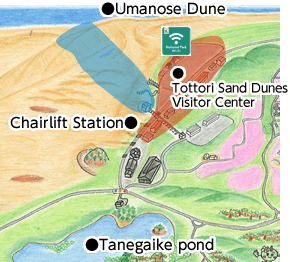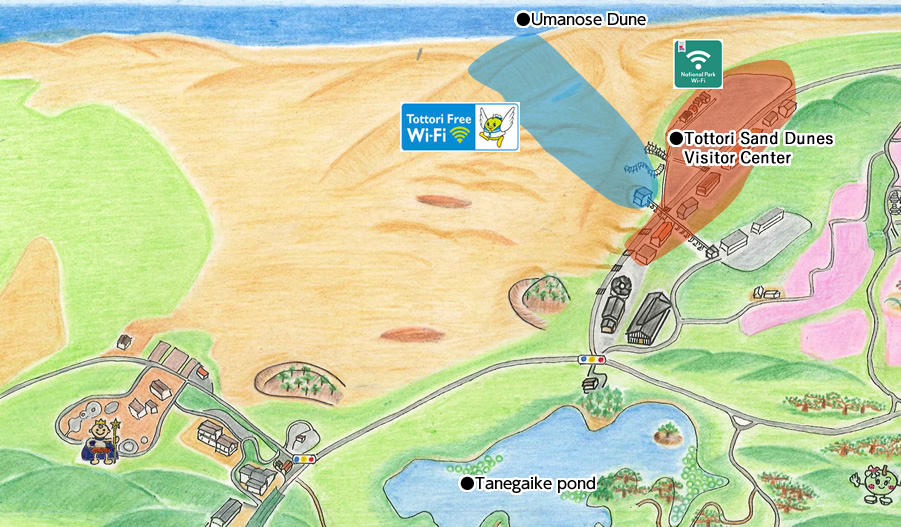San’in Kaigan National Park
Museum of Terrain and Geology
HISTORY
About San'in Kaigan National Park
San’in Kaigan National Park is a Japanese national park with approx. 75km of coastline facing the Sea of Japan from Amino coast of Tango in Kyoto, through Tajima Mihonoura in Hyogo Prefecture to Tottori Sand Dunes in eastern Tottori Prefecture. The area centered on this national park is certified as the San’in Kaigan UNESCO Global Geopark.
Characteristics of San'in Kaigan National Park
The San’in Kaigan Naional Park comprises approx. 75km of coastline from Kyotango City in Kyoto in the east to Tottori City in Tottori Prefecture in the west. The characteristic of this coastline is the richly varying coastal landscape where the mountains connect to the ria coast (submergent coast), comprise landforms of sea cliffs, sea caves, and reefs are remarkably developed. Another characteristic is the expansive sand dune landscape, represented by the Tottori Sand Dunes, that have been formed through wave erosion and by sand carried from the mouth of the river. In this way, unique terrain can be seen throughout the national park, and because these terrains comprise various types of rocks, the park is also referred to as the “Geological Park” or “Beautiful Rock Park.” In 2010, the San’in Kaigan Geopark, centered on the San’in Kaigan National Park, was registered with the Global Geopark Network. This also recognizes the global importance of the San’inkaigan Coastline.
Terrain, Scenery
The rocky coastline is the main characteristic scenery of the Sanin Kaigan National Park. Sea cliffs, sea caves, reefs, and other landforms have developed remarkably due to the erosion and weathering caused by the rough waves and seasonal winds from the Sea of Japan, and the coastline has become a complex intricate ria coast (submergent coast). Also, because the coastline contains abundant in a variety of rocks and geological structures, there are unique terrains dotted throughout the park. The sandy beaches, which are the scenery that contrasts with the rocky coasts, are formed by sand generated by sea erosion and sand carried from river mouths. The typical scenery of the sandy coastline at this park, Tottori Sand Dune’s unique landscape has been formed by sand movement.
The geology in the park mainly consists of volcanic rocks of basalt, andesite, and rhyolite (many joints can be seen throughout the park) and pyroclastic rock and sedimentary rocks of conglomerate, sandstone and mudstone, and granite can also be seen in some area.A variety of occurrences and geological structures such as stratification, non-conformity, jointed dikes, etc. created by those rocks can also be seen at San’in Kaigan National Park.
Efforts of San’in Kaigan National Park
■Tottori Sand Dunes Landscape Restoration Project
In the Tottori Sand Dunes, the weakening of sand movement caused a significant influx of non-native plants into the Tottori Sand Dunes area, this has led to further weakens the sand movement and impaired the landscapes peculiar to the sand dunes, such as the wind ripples.
To counter this situation, weeding of sand dunes led by Tottori City and Tottori Prefecture is carried out. Nowadays, the movement of sand has been revived and literally “Active Sand Dunes” are steadily returning.
■Park Volunteers
In the national park, the Ministry of the Environment registers people who wish to proactively cooperate in various activities such as commentary for nature observation meetings, beautification and clean-up, and simple maintenance and repair of the park facilities as park volunteers. Park volunteers at San’in Kaigan National Park are mainly based at the Takeno Snorkeling Center, and provides commentary for observation marine life living inshore and observe the underwater environment using snorkels, etc. Volunteers also carry out beach clean-up, gather information about nature, and conduct biological habitat surveys, conveying the appeal of San’in Kaigan National Park to visitors.




